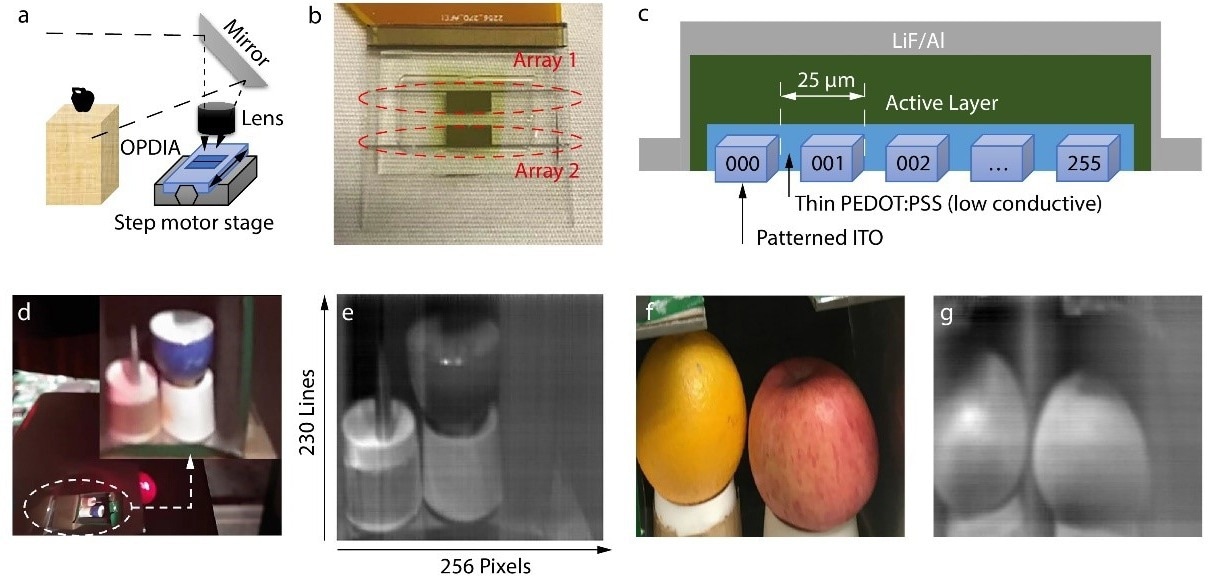Reviewed by Lexie CornerMay 10 2024
Researchers at the South China University of Technology recently discovered a novel class of infrared photodetectors based on organic semiconductors. These findings were published in the Chinese Journal of Polymer Science and have the potential to revolutionize imaging technology. These organic photodiodes outperform conventional inorganic detectors throughout a broad range of wavelengths, from near-ultraviolet to short-wavelength infrared.
 The schematic illustrations and performance of a SWIR image system based on linear image arrays using organic photodiodes reported in this work. Image Credit: Chinese Journal of Polymer Science
The schematic illustrations and performance of a SWIR image system based on linear image arrays using organic photodiodes reported in this work. Image Credit: Chinese Journal of Polymer Science
There is an increasing demand for high-count, low-cost focal-plane arrays in the Near-Infrared (NIR) and Short-Wavelength Infrared (SWIR) spectra because of their potential uses in AI-driven technologies (such as robots, autonomous cars, augmented/virtual reality, and 3D face identification).
Conventional SWIR photodiodes are based on indium gallium arsenide (InGaAs) or crystalline germanium (Ge), which have complicated fabrication procedures and high dark currents. A viable substitute has emerged in organic semiconductors, which may be simpler to manufacture and have adjustable optical characteristics.
Employing narrow bandgap polymer semiconductors, the group produced thin-film photodiodes that could detect a wide spectrum of infrared wavelengths. At a fraction of the cost, this novel technology achieves performance levels comparable to conventional inorganic photodetectors, such as those produced from indium gallium arsenide (InGaAs).
Larger heteroatoms, regio-regular backbones, and longer branching positions on side chains were the tactics combined by the researchers to create polymer semiconductors with a spectrum response ranging from near-ultraviolet to short-wavelength infrared.
The resultant devices were competitive with InGaAs-based detectors in terms of specific detectivity, achieving 5.55 × 10¹² Jones at 1.15 μm. A distinctive feature of these organic photodetectors is that they did not require pixel-level patterning in the sensing layer when built into high-pixel-density picture arrays. This method streamlines the production process and significantly reduces costs.
Our development of organic photodetectors marks a pivotal step toward cost-effective, high-performance infrared imaging technology. These devices offer a flexible and scalable alternative to traditional inorganic photodiodes, with potential applications ranging from industrial robotics to medical diagnostics.
Fei Huang, Professor and Lead Researcher, South China University of Technology
These novel organic photodetectors have the potential to have a big influence on various sectors. They provide an affordable substitute for imaging systems used in surveillance and security applications.
The organic-based technology may result in more widely available and reasonably priced medical imaging equipment, enabling a more comprehensive range of applications in healthcare environments. These gadgets' scalability and adaptability also pave the way for cutting-edge robotics and artificial intelligence applications.
The study was funded by the National Natural Science Foundation of China (Nos. U21A6002 and 51933003) and the Basic and Applied Basic Research Major Program of Guangdong Province (No. 2019B030302007).
Journal Reference:
Zhong, Z, M., et al. (2023) Infrared Photodetectors and Image Arrays Made with Organic Semiconductors. Chinese Journal of Polymer Science. doi.org/10.1007/s10118-023-2973-8.